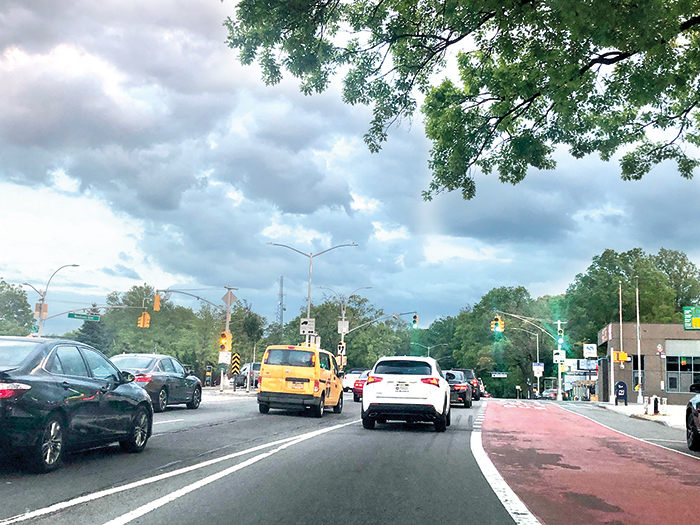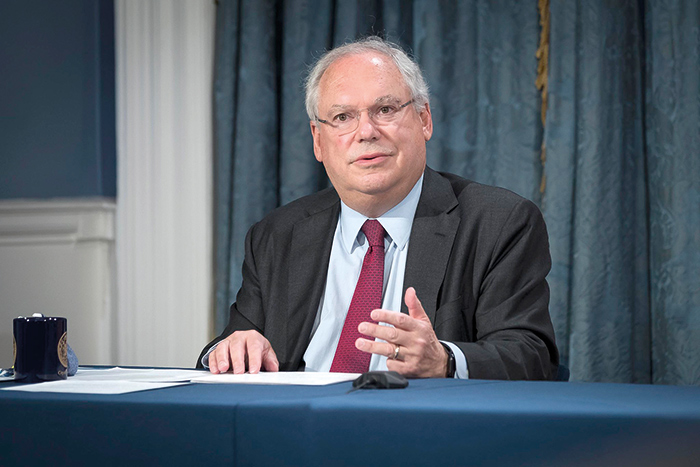Photo Courtesy of Ed Reed/Mayoral Photography Office
“We will not only lower speed limits on some of the city’s most crash-prone corridors, we will redouble our efforts to expand the hours when these life-saving speed cameras are in operation,” DOT Commissioner Gutman said.
By Michael V. Cusenza
Speed limits will be reduced on 45 miles of major streets with some the highest rates of crashes across Queens, Brooklyn, the Bronx, and Staten Island, Mayor Bill de Blasio announced Monday.
The NYPD will conduct a weeklong pedestrian and cyclist safety enforcement blitz, across all 77 patrol precincts, to crack down on drivers who speed and fail to yield, Hizzoner noted.
Plan highlights:
Lower Speed Limits on High-Crash Corridors:
Last year, DOT lowered speed limits by 5 MPH on eleven corridors citywide, totaling about 25 miles. The newly targeted corridors this year in Queens, Brooklyn, The Bronx, and Staten Island represent 45 miles of streets.
Street locations, mileage, and speed limit changes are as follows:
Queens:
- Woodhaven Boulevard from Queens Boulevard to Rockaway Boulevard, 4.3 miles (30 MPH to 25 MPH)
- Cross Bay Boulevard from Rockaway Boulevard to the Cross Bay North Boulevard Bridge, 2.5 miles (30/40 MPH to 25/35 MPH)
- Van Wyck Service Road E/W from 135th Avenue to Queens Boulevard, 3.1 miles (30 MPH to 25 MPH)
- Astoria Boulevard from 111th Street to 8th Street, 3.9 miles (30 MPH to 25 MPH)
- South Conduit Avenue from Sutter Ave to Sunrise Highway, 5.3 miles (35 MPH to 30 MPH)
- North Conduit Avenue from Sutter Ave to Sunrise Highway, 6.6 miles (35 MPH to 30 MPH)
Brooklyn:
- Conduit Boulevard from Atlantic Avenue to Sutter Ave, 1.9 miles (35 MPH to 30 MPH)
New speed limits will go into effect as speed-limit signage is posted over the coming weeks. Speed cameras located along any of these streets will be reprogrammed and drivers will be given a 60-day adjustment period after new signage is posted.
NYPD Enforcement

Forum Photo by Michael V. Cusenza
Under the new plan, the speed limit on Woodhaven Boulevard from Queens Boulevard to Rockaway Boulevard will decrease to 25 mph from 30 mph.
The NYPD is placing significant emphasis on a multifaceted pedestrian and cyclist safety operation during the week of May 10 through May 16. This effort is anchored by increased focus on combating motorists who speed and fail to yield to pedestrians and cyclists. It is a comprehensive, citywide operation, to be carried out in all 77 patrol precincts. The effort will incorporate all the Transportation Bureau’s units and deploy additional Patrol Services.
Each Precinct will assign their traffic safety team to participate in these stepped-up efforts to combat traffic injuries. Officers will concentrate their enforcement on drivers who speed and drivers who fail to yield to pedestrians and cyclists. Enforcement will be focused at specific intersections and the corresponding corridors where the data shows a high frequency of pedestrian and cyclist injuries as a result of being struck by a vehicle.
NYPD Highway Patrol will focus enforcement efforts on high-crash highways to catch speeding before dangerous drivers come into close proximity with the cyclists and pedestrians.
The Traffic Enforcement District will focus its high-volume enforcement on vehicles that are obstructing bike lanes while parked, and it has specifically dedicated enforcement resources in each borough to keep bike lanes clear for cyclists. Vehicles that are summonsed for obstructing a bike lane are eligible to be towed to the NYPD’s violation tow pound.
“Drivers that make the choice to speed with their vehicles, and drivers that fail to yield to pedestrians and cyclists, will be the subject of additional traffic enforcement during this important initiative,” NYPD Chief of Transportation Kim Royster said.
Speed Cameras
In December 2020, the mayor proposed expanding the State law that governs the hours during which speed cameras are operational. Under the current law passed in 2019, cameras are limited to operate only during the hours of 6 am to 10 pm on weekdays. The proposal would make cameras operational 24 hours a day, seven days a week. An analysis of 2020 fatal crashes shows that 36% of all traffic deaths this year that were not on highways occurred within school speed zones where permanent cameras are located, but happened during hours – on nights and during weekends – when the automated enforcement cameras were not legally allowed to issue summonses.
For the first time, the Department of Transportation also released a Citywide map (above) showing the locations of the 750 school zones with fixed automatic speed cameras – the largest speed camera program in the world. Over 1,300 speed cameras are now active citywide; DOT plans to have 2,000 active cameras by the end of 2021. According to DOT’s latest speed camera report:
- Speeding has been reduced on average by over 70 percent at locations where speed cameras are installed.
- Injuries are down 17 percent at these same locations.
- Two-thirds of vehicle owners who received a notice of liability in 2019 did not receive another within the calendar year.
According to the DOT, a pedestrian who is struck by a vehicle traveling at 30 MPH is twice as likely to be killed as a pedestrian struck by a vehicle traveling at 25 MPH.
Last week, de Blasio called on the State Legislature to pass the Crash Victim Rights and Safety Act, a series of bills designed to take aggressive action against dangerous driving and support the families of crash victims. The legislation includes a bill of rights for traffic crash victims, lowing the blood alcohol concentration limit, DMV pre-licensing courses, and 24/7 operation of speed cameras, among many other life-saving safety initiatives.
“Speeding is a leading cause of traffic fatalities – and we also know that less driving during COVID-19 led to an increase in speeding,” said DOT Commissioner Hank Gutman. “So under the mayor’s leadership, we will not only lower speed limits on some of the city’s most crash-prone corridors, we will redouble our efforts to expand the hours when these life-saving speed cameras are in operation. These cameras now cover a majority of the City in an incredibly diverse range of neighborhoods. Important to note, in 2020, a shocking one third of fatal crashes happened in camera zones, but unfortunately during hours when the cameras were not allowed to operate. With the help of Albany, we need to fix that.”

